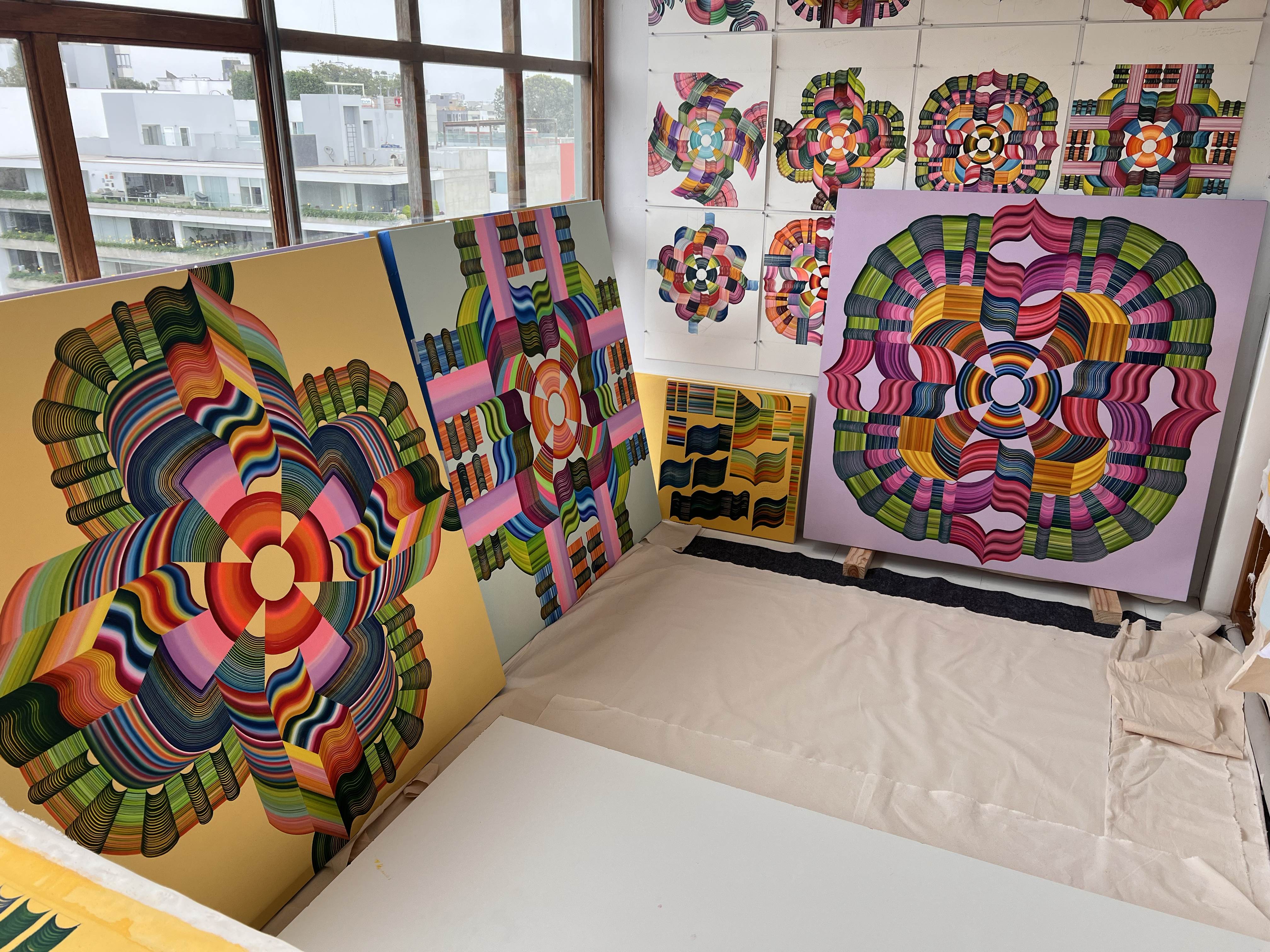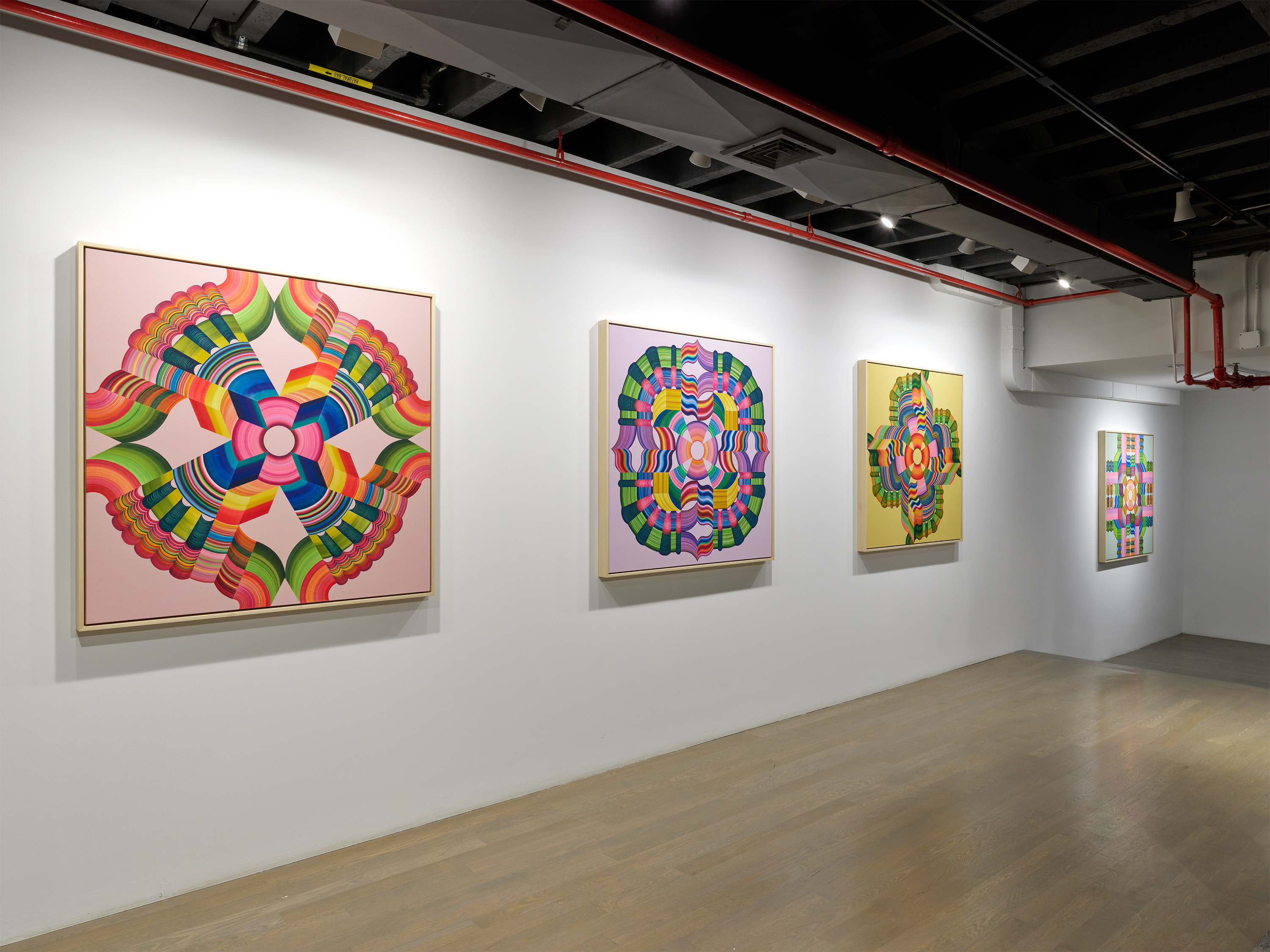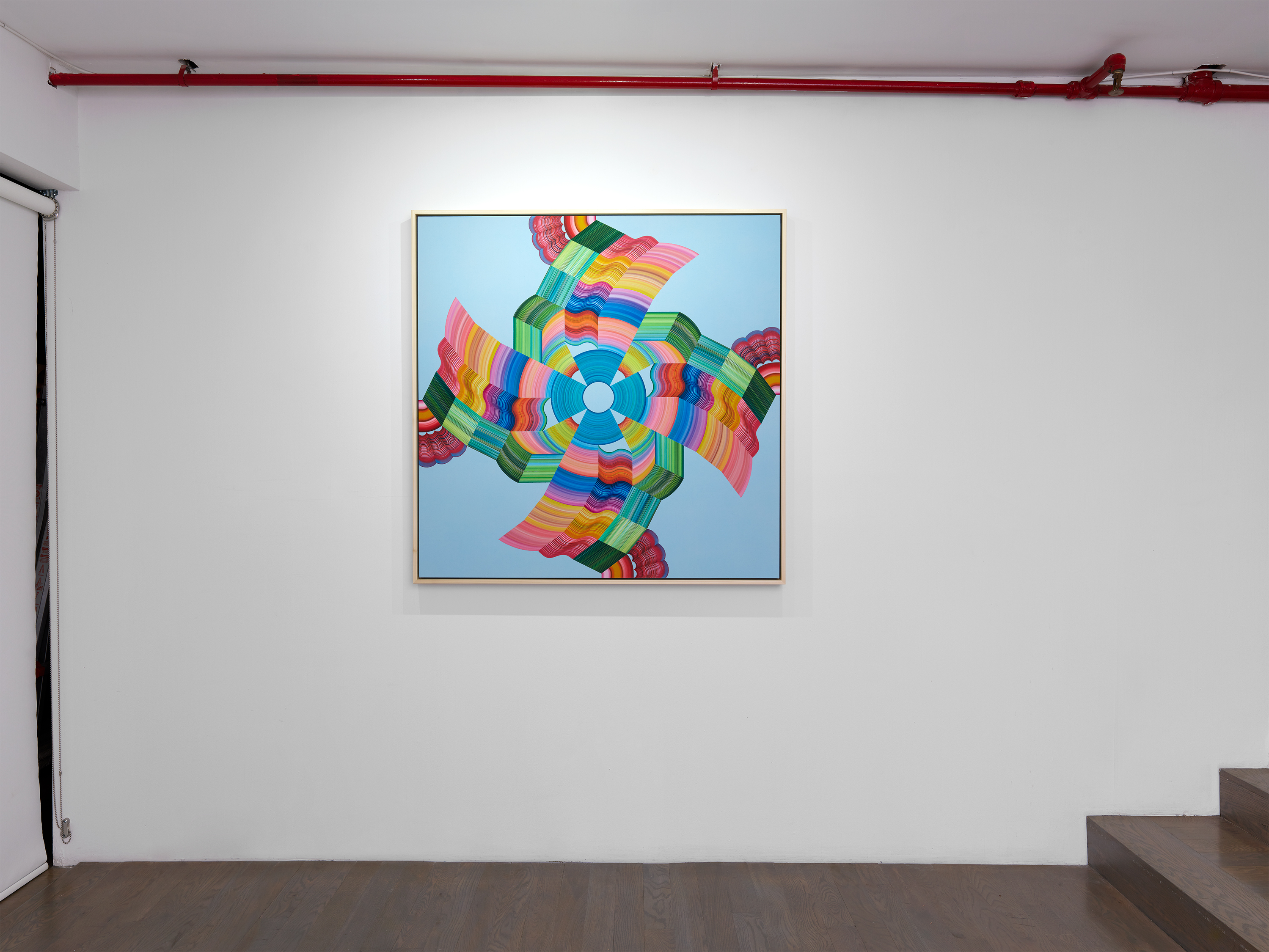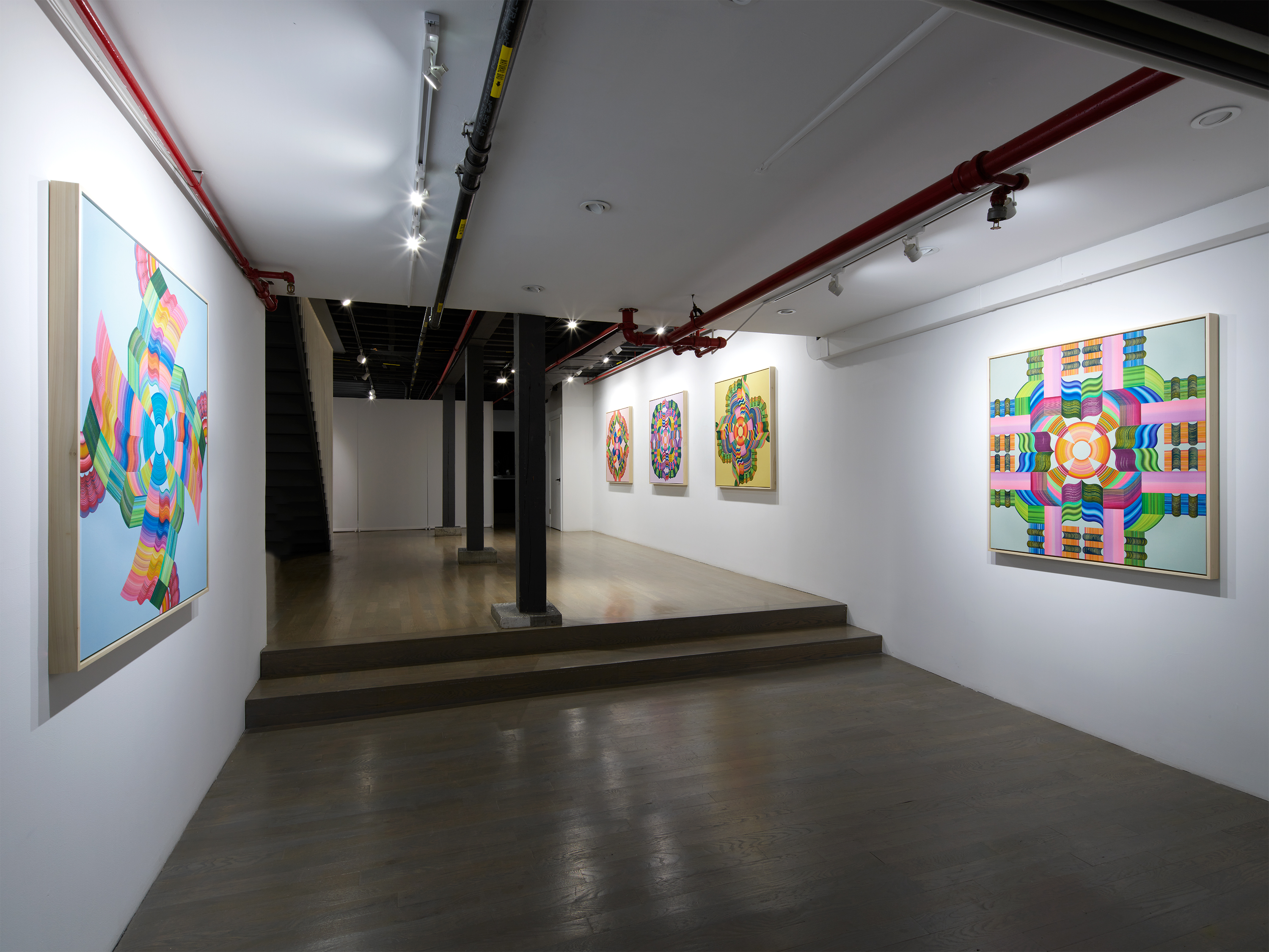PROJECTION 006: ISABELLA CUGLIEVAN
The Wallpaper of the Forest
NOVEMBER 10, 2022 - JANUARY 14, 2023
“A carpet of mosses does in fact provide this lustrous green light. But, focus the lens on the mossy wallpaper itself and the green blur of the background resolves itself into sharp focus and an entirely new dimension appears. The wallpaper, which seemed at first glance to be of uniform weave, is in fact a complex tapestry, a brocadesurface of intricate pattern. [...] Slowing down and coming close, we see patterns emerge and expand out of the tangled tapestry threads. The thread are simultaneously distinct from the whole, and part of the whole.”
— Robin Wall Kimmerer, Gathering Moss
— Robin Wall Kimmerer, Gathering Moss

CHART is pleased to present our sixth PROJECTION exhibition, The Wallpaper of the Forest, a presentation of five new abstract paintings by Isabella Cuglievan. The exhibition will open on Thursday, November 10, from 6 – 8 pm, and will be on view through Saturday, January 14, 2023.
The exhibition, which takes its title from a line by scientist and bryologist Robin Wall Kimmerer, who elegantly examines a common but largely overlooked element of the natural world, features Cuglievan’s artfully constructed paintings, each inundated with intricate and exacting brushstrokes. Patterns are painstakingly applied by hand, as the artist slowly and delicately builds a web of symmetrical compositions, that are one part disciplined control, and one part kaleidoscopic explosion.
There is something poetic about pattern, and Cuglievan’s accretions of color echo both the traditional textiles of her native Peru, as well as weaving practices from around the world. Rather than serving as direct references however, those visual cues act as avenues for aesthetic appreciation — the ways in which combinations of clor can express one’s relationshop to the natural world or turn small, fleeting details into a rich and expansive tapestry.
The exhibition, which takes its title from a line by scientist and bryologist Robin Wall Kimmerer, who elegantly examines a common but largely overlooked element of the natural world, features Cuglievan’s artfully constructed paintings, each inundated with intricate and exacting brushstrokes. Patterns are painstakingly applied by hand, as the artist slowly and delicately builds a web of symmetrical compositions, that are one part disciplined control, and one part kaleidoscopic explosion.
There is something poetic about pattern, and Cuglievan’s accretions of color echo both the traditional textiles of her native Peru, as well as weaving practices from around the world. Rather than serving as direct references however, those visual cues act as avenues for aesthetic appreciation — the ways in which combinations of clor can express one’s relationshop to the natural world or turn small, fleeting details into a rich and expansive tapestry.
Here, Cuglievan uses the flower, not as a metaphorical symbol, but as a formal element, treating the concept almost as scaffolding for the paintings, through which to explore ways of expanding and shifting the work.
The new works on view, Cuglievan’s largest paintings to date, incorporate several returning brushstroke movements — a curly bracket resembling an “open book”, a right-turn hook becoming a “fold” — as well as a new movement derived from the growth of plant stems — a “shoot”, long gradients that, like the other marks, serve to guide the eye from one part of the painting to the next.
Much like the gradual opening of a blossoming flower bud, the unfolding nature of Cuglievan’s process uses symmetry as a means for elaboration. While the individual elements contain a delicate intimacy, it is in the repetition of the pattern, in conjunction with comprehension of the whole, where the true beauty appears. As Kimmerer states in her chapter “Learning to See”, “Not until the pattern is repeated, with feedback from the conscious mind, so we know what we are seeing.”
The new works on view, Cuglievan’s largest paintings to date, incorporate several returning brushstroke movements — a curly bracket resembling an “open book”, a right-turn hook becoming a “fold” — as well as a new movement derived from the growth of plant stems — a “shoot”, long gradients that, like the other marks, serve to guide the eye from one part of the painting to the next.
Much like the gradual opening of a blossoming flower bud, the unfolding nature of Cuglievan’s process uses symmetry as a means for elaboration. While the individual elements contain a delicate intimacy, it is in the repetition of the pattern, in conjunction with comprehension of the whole, where the true beauty appears. As Kimmerer states in her chapter “Learning to See”, “Not until the pattern is repeated, with feedback from the conscious mind, so we know what we are seeing.”

Wingspan, 2022
acrylic ink, watercolor, and flashe on canvas stretched over panel
44 x 44 x 1 1/2 inches (111.8 x 111.8 x 3.8 cm)

Wallflower, 2022
acrylic ink, watercolor, and flashe on canvas stretched over panel
44 x 44 x 1 1/2 inches (111.8 x 111.8 x 3.8 cm)

Reverie, 2022
acrylic ink, watercolor, and flashe on canvas stretched over panel
44 x 44 x 1 1/2 inches (111.8 x 111.8 x 3.8 cm)

Shoots, 2022
acrylic ink, watercolor, and flashe on canvas stretched over panel
44 x 44 x 1 1/2 inches (111.8 x 111.8 x 3.8 cm)

Spinning Petrea, 2022
acrylic ink, watercolor, and flashe on canvas stretched over panel
44 x 44 x 1 1/2 inches (111.8 x 111.8 x 3.8 cm)
IN CONVERSATION WITH THE ARTIST
CHART:
The title of the exhibition comes from biologist Robin Wall Kimmerer’s book, Gathering Moss. How did you first encounter Kimmerer’s writing and what influence has it had on your artistic practice?
ISABELLA:
I read Gathering Moss for the first time about two years ago. I was working on my first solo show at the time and ended up titling the show “The Advantages of Being Small” after a chapter in the book. I was making small paintings because I hadn’t figured out a way to work larger with my method of painting. I was also working out of a tiny studio. Kimmerer laid out that mosses are successful because they are able to do so much with very little. That they don’t thrive despite their size, but because of it. This struck a cord not just with ideas surrounding my work, but with notions I had about how to exist in this world.
A little over a year later I found myself working on this show and listening to Robin Wall Kimmerer narrate the book as I worked, perhaps for the tenth time. And in ways I can only hope my paintings will ever do, a new beautiful image was revealed to me. Kimmerer writes that her former husband would teasingly refer to mosses as pure decoration, or, as she goes on to say, “the wallpaper of the forest.” She explains that all it takes is a change in focus—a simple adjustment of the eyes and the mind—in order to see the complex tapestry of mosses: a majestic forest in itself, simply existing at a different scale.
In a way, this book has been a companion to me on my painting journey of the last two years, and as my practice evolves it continues to offer new ways of thinking about what I make. It has given me comfort when feeling insignificant or invisible, but still having so much to give. It has taught me to look at the magic of nuance, of pattern and of form. Having encountered this book is a beautiful gift; it just keeps on giving. My only wish is to give back with what I create. To hopefully bring some wonder to whoever pays attention to the work.
A little over a year later I found myself working on this show and listening to Robin Wall Kimmerer narrate the book as I worked, perhaps for the tenth time. And in ways I can only hope my paintings will ever do, a new beautiful image was revealed to me. Kimmerer writes that her former husband would teasingly refer to mosses as pure decoration, or, as she goes on to say, “the wallpaper of the forest.” She explains that all it takes is a change in focus—a simple adjustment of the eyes and the mind—in order to see the complex tapestry of mosses: a majestic forest in itself, simply existing at a different scale.
In a way, this book has been a companion to me on my painting journey of the last two years, and as my practice evolves it continues to offer new ways of thinking about what I make. It has given me comfort when feeling insignificant or invisible, but still having so much to give. It has taught me to look at the magic of nuance, of pattern and of form. Having encountered this book is a beautiful gift; it just keeps on giving. My only wish is to give back with what I create. To hopefully bring some wonder to whoever pays attention to the work.
CHART:
Where were you creatively when you first started this new body of work? Were there new directions or avenues you knew you wanted to explore for this show?
ISABELLA:
I wanted to explore the possibilities that single shape could offer as a starting point. All five works have a “flower” shape at its center. It acts as both a beginning and a scaffolding for the painting. The four initial brushstrokes or “petals” comprising the center shape, provide a structure for pattern and color to develop as it radiates outwards. I seek to arrive at a complexity that is wholly of my creation but that at the same time gives the sense that it could already exist in this world, whether it be in nature or as something man-made. Ultimately, whatever it is that these paintings are interpreted as, my only hope is that it is perceived as something in its fullest splendor.



CHART:
From the studio shots you’ve shared with us, I couldn’t help but notice the series of countless preparatory brushstrokes. Given your meticulous application techniques, how much planning and forethought goes in to creating these paintings?
ISABELLA:
Each painting begins with a preparatory drawing that is more a study of composition than of color. These studies allow me to treat negative or “breathing” space with intention rather than as a residue.
Translating the drawing into a larger painting implies scaling up the width of the brush in proportion to the new dimension of the work. With a precise roadmap for the structure of the painting at hand, I can be more bold and intuitive with color. Before applying a brushstroke, I often test the color on a separate surface. It’s a way of testing the imprint of the brush before it goes on the actual painting, because once it is there it cannot be removed. With each repetition of a brushstroke these surprising nuances begin to appear and that energy is ultimately transferred to the painting itself.
Translating the drawing into a larger painting implies scaling up the width of the brush in proportion to the new dimension of the work. With a precise roadmap for the structure of the painting at hand, I can be more bold and intuitive with color. Before applying a brushstroke, I often test the color on a separate surface. It’s a way of testing the imprint of the brush before it goes on the actual painting, because once it is there it cannot be removed. With each repetition of a brushstroke these surprising nuances begin to appear and that energy is ultimately transferred to the painting itself.


Isabella’s studio in Lima, Peru.
INSTALLATION VIEWS







Installation views at CHART. Photos by Elisabeth Bernstein.
Isabella Cuglievan (b. 1993, Peru) lives and works in Lima, Peru. The artist received a BA from Middlebury College in Middlebury, Vermont. Cuglievan had a solo presentation at Marvin Gardens in Ridgewood, New York (2021), and her work has also been exhibited at The Pit, with Tamara Gonzales, in Palm Springs, California (2022); Sebastian Gladstone, with Dino Capaldi, in Los Angeles, California (2022); KDR305, with Adrianne Rubenstein, in Miami, Florida (2021); among others.
© 2023 CHART
ALL ART WORKS COPYRIGHT THE ARTIST
ALL ART WORKS COPYRIGHT THE ARTIST
PROJECTION is an initiative alongside our main gallery programming, highlighting diverse voices in intimate presentations. PROJECTION features artists in the naissance of their careers or those that have been overlooked, working across a variety of mediums and formats. All PROJECTION exhibitions will take place concurrently in two venues: our downstairs gallery space and online in our PROJECTION ROOM.